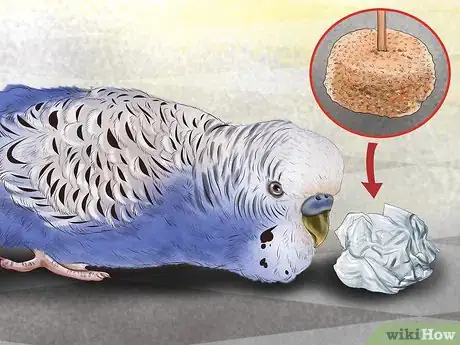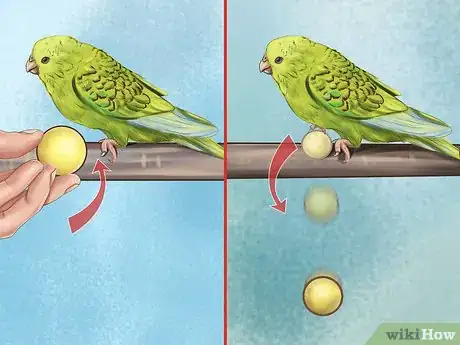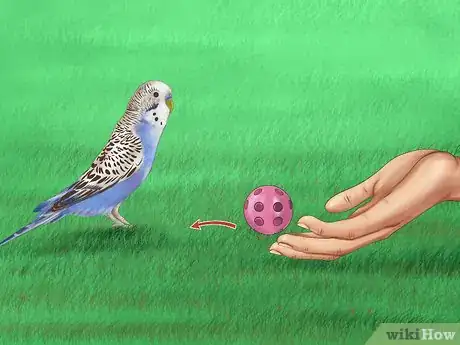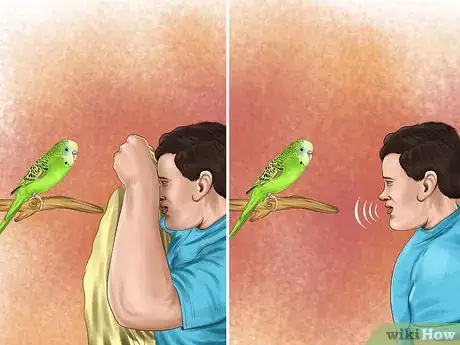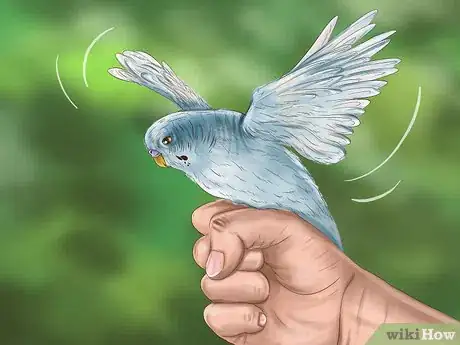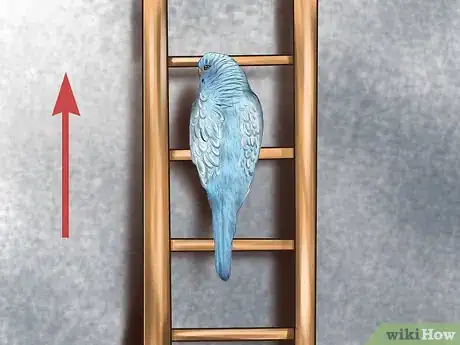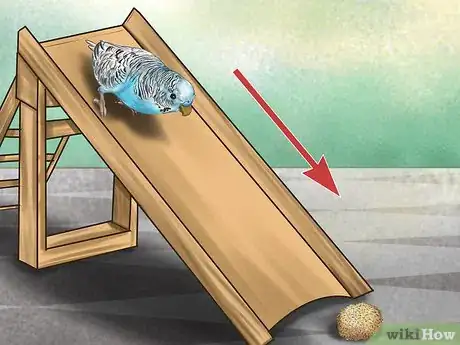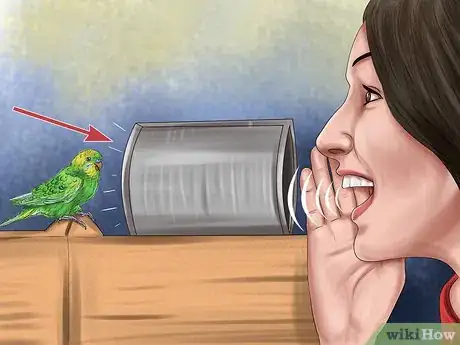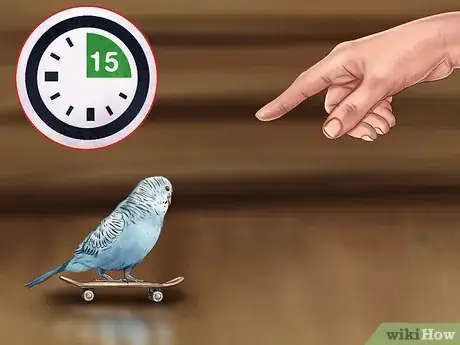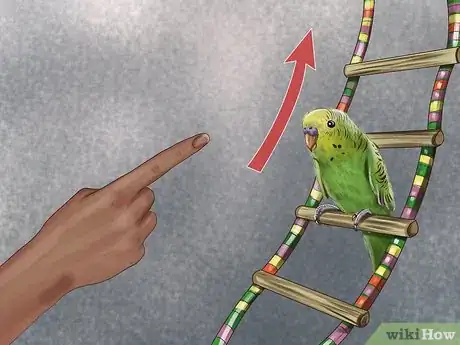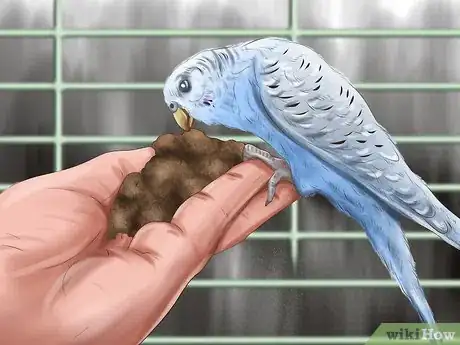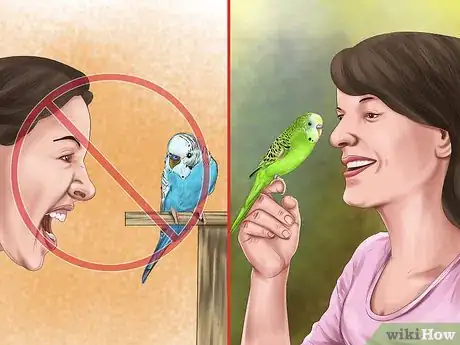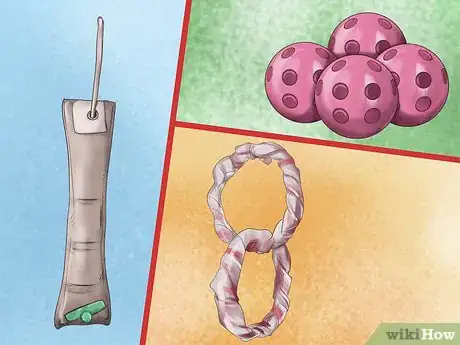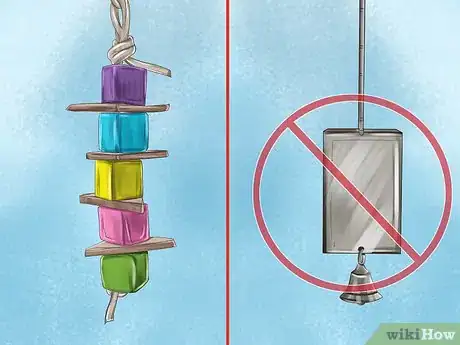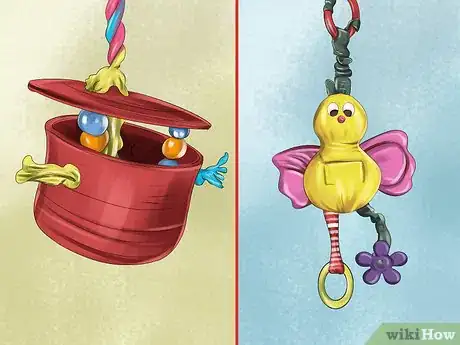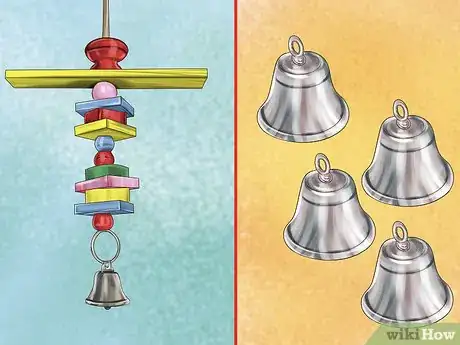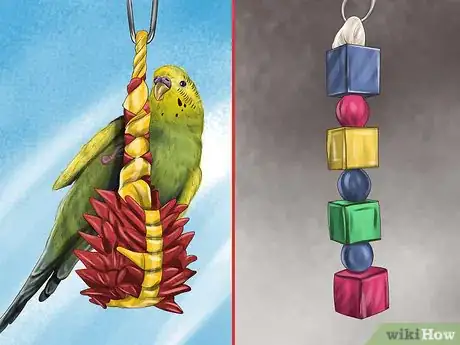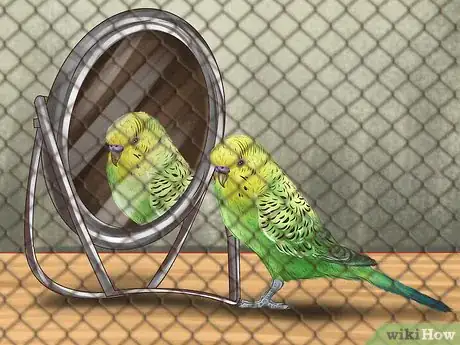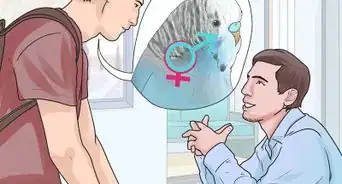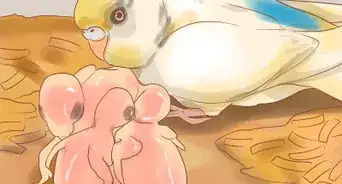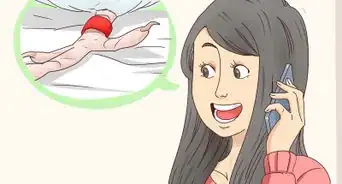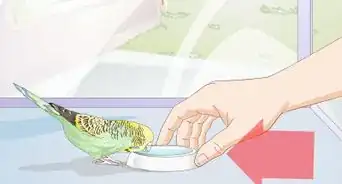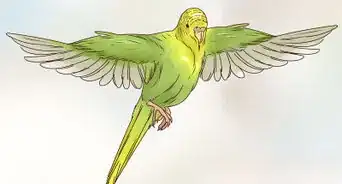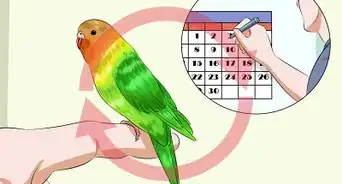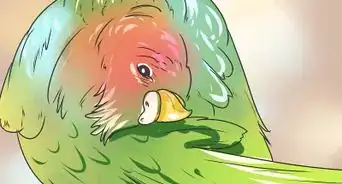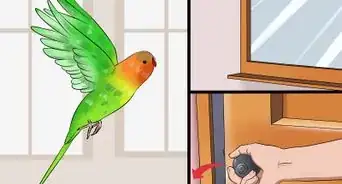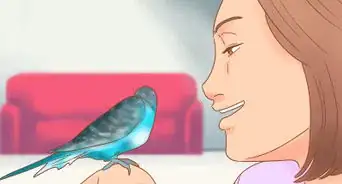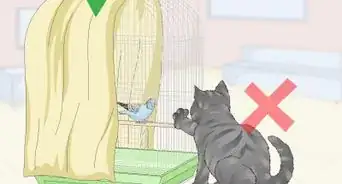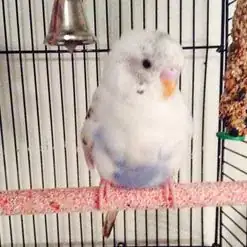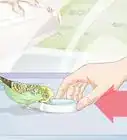This article was co-authored by Pippa Elliott, MRCVS. Dr. Elliott, BVMS, MRCVS is a veterinarian with over 30 years of experience in veterinary surgery and companion animal practice. She graduated from the University of Glasgow in 1987 with a degree in veterinary medicine and surgery. She has worked at the same animal clinic in her hometown for over 20 years.
There are 8 references cited in this article, which can be found at the bottom of the page.
wikiHow marks an article as reader-approved once it receives enough positive feedback. In this case, 92% of readers who voted found the article helpful, earning it our reader-approved status.
This article has been viewed 106,587 times.
Parakeets (or budgies) are extremely intelligent animals that enjoy high levels of socialization and play. They are capable of playing with a number of toys and appreciate an engaging living space. Once you have properly perch trained and hand trained your parakeet, you can begin playing games with it and teaching it tricks. Play is important because it exercises the bird, helping it stay physically healthy, and promotes socialization. In order to create a fun experience for you and your parakeet, you should play with it regularly, train it to do tricks, and provide it with appropriate toys.
Steps
Playing Games with Your Parakeet
-
1Disguise treats. Because parakeets are foragers and enjoy taking things apart with their beaks, your parakeet will appreciate taking things apart and finding a treat. An easy game to play with your parakeet is to wrap up a treat in paper and allow your bird to pull it apart. You can fold the paper or simply ball it up, either way your bird will enjoy finding the treat in the middle.[1]
- Paper foraging games are particularly useful for training a young bird to play. Once your bird is older you may want to consider soft-wood foraging toys.
-
2Fetch the ball. Find something that is small enough to fit in your parakeet’s claw and hand it to them. If it throws the object on the ground, pick it up and hand it to the bird again. Although you might find this a little repetitive, your bird is having a good time and is being better socialized.[2]
- If your bird is not interested in playing fetch, do not worry. Try again another time or play a different game.
- In order to encourage the bird to continue playing the game, give it a treat and an encouraging remark like “Good job!” every time that it throws the object.
Advertisement -
3Play catch. Take your parakeet out of its cage and set it on the ground. Then, roll a small ball towards it. Your parakeet may follow the ball and attempt to grab it with its beak. However, the bird will not return the ball to you, so you may have to go retrieve it from them.[3]
- Use a whiffle ball or something with notches big enough for your bird to grab with its beak.
- In order to encourage the bird to continue playing the game, give it a treat and a supportive remark like “Good job!” every time that it gets the ball.
-
4Play peek-a-boo. Place your parrot on your bed or floor and cover your head with a sheet or towel. Peek your head out of the sheet and call your bird’s name. Then cover it and say your bird’s name again. Your parakeet will begin following the sound of your voice and be excited every time you reappear.[4]
- If your bird is comfortable with this, you can also put your bird under the sheet and play peek-a-boo that way. Just be careful not to let your parakeet stay under the sheets for too long and make sure they have enough air.
-
5Practice flying. Perch your bird on your finger and gently hold both of its feet. Carefully lift it above your head. As you raise it, the bird will begin flapping its wings. Let it flap its wings for a few moments and then bring it back down. Repeat this process as long as you want or until the bird gets tired of it.[5]
- Before you play this game, make sure that any ceiling fans are off and that the space above you is open.
- Parakeets and other members of the parrot family naturally flap their wings when perched to exercise their wings. This game mimics this natural exercise. [6]
Training Your Parakeet to Do Tricks
-
1Get your parakeet to go up a ladder. A simple trick that you can train your parakeet to perform is climbing a ladder. Because they are natural climbers, your parakeet will instinctively want to climb a ladder. However, you can train it to associate this activity with a verbal cue and a treat so that the bird will climb on command. Place the bird at the end of a ladder, say the cue, and reward it with a treat when it does what you command.[7]
- Examples of a verbal cue might be “up the ladder” or “climb the ladder.”
- You can buy a ladder for your parakeet at most pet stores.
-
2Have your bird go down a slide. Place a slide at the other end of your parakeet’s ladder. Initially, give it praise and a treat once it reaches the top of the ladder and touches the slide. Then, place a treat at the bottom of the slide. Eventually, your bird will slide down and get the snack.[8]
- It is easier if you break tricks down and teach them in steps. Train your bird how to climb the ladder before instructing it on how to go down a slide.
- You may have to make your own slide out of PVC pipe since commercially available parakeet slides are hard to come by.
-
3Teach it to go through a hoop. Create a small hoop for your parakeet out of cardboard or other light material. Lead your parakeet through the hoop with a treat and assign a cue every time it goes through. Eventually, you may want to insert increasingly longer pieces of tubing for the hoop.[9]
- A paper towel or toilet paper tube should be about the right size for a parakeet.
-
4Hold short training sessions. When you begin teaching your parakeet tricks, you will want to limit the length of you training sessions. Pushing your bird too hard will cause it to lose interest and may make it ill. Stop training your bird if it looks tired or loses interest.[10]
- The time spent training your bird could last anywhere from a few minutes to a half hour.
- Try having training sessions a couple of times a day.
-
5Give them cues. Parakeets are particularly adept at responding to verbal cues from humans, but they can also recognize physical gestures. When training your parakeet, pick a cue and stick with it. Consistency and repetition are essential. Once the bird has associated the cue with the activity, they will respond on command.[11]
- A physical cue can be a snap of the fingers of a wave of the hand.
- A verbal cue can be a short phrase like “up the ladder” or “down the slide.” It can also as simple as a word like “up” or “down.”
-
6Reward your bird. Whenever your bird does what you want it to do, give it a treat. This positive reinforcement will ensure that it associates your cue, and the action is has performed, with the treat it receives at the end. You can also reward the bird at the end of a session with a treat in its bowl that it does not regularly eat.[12]
- Consider a hulled sunflower seed or a piece of millet spray as a quick treat.
-
7Speak in a positive tone. Parakeets are perceptive birds and will respond to your attitude. If you stay positive and enthusiastic, the bird will focus and stay on task. If you become frustrated and agitated, the bird will likely be distracted and lose interest in the training. To avoid this, stay positive and make the activities fun.[13]
- Maintaining a positive tone is essential to keeping training fun and light.
Finding the Right Toys
-
1Evaluate how your bird likes to play. Before you buy your parakeet toys, test out the ways in which it likes to play. Make paper foraging toys or weave pieces of paper through its cage. Give it small objects from around the house like bottle caps or little balls and see how it reacts to them. This will help you determine what kinds of toys to invest in.
- You may also find that your bird enjoys the simple toys just as much as ones you bought at a pet store.
- Make sure that you give your bird safe things to play with. Avoid anything treated with harsh chemicals or solvents.
-
2Find safe toys. Make sure that the toys you are giving your bird are appropriate for their size. Parakeets can get stuck and die in toys intended for larger birds. You should also avoid any toys with sharp edges that could poke your bird or lose strings that could strangle them.
- If you are in doubt about the safety of a toy, talk to a clerk at your pet store or email the toy retailer.
-
3Pick brightly colored toys. Because parakeets can see the full spectrum of colors, they are particularly attracted to colorful objects. When considering toys, you should buy things that have vibrant coloring. Bright primary colors, like yellow, red, and blue, are great choices. Although you can give your bird toys that are drably colored, they may not play with them as much.[14]
- Be sure to choose toys that are colored with non-toxic materials.
-
4Choose noisy toys. Parakeets are social birds by nature and make a lot of noises. Because of this, they also enjoy toys that make a lot of sound. Toys with bells attached to them are particularly popular with parakeets. You can also hang a few small bells in your birds cage.
- Avoid buying the Christmas style “jingle bell” with openings. Your parakeet may get stuck in the holes. Instead, buy an open-bottomed bell.
-
5Buy foraging toys. Parakeets are particularly fond of toys that mimic foraging activities. Because parakeets have smaller beaks, you will want to invest in foraging toys that are made of soft-woods or cardboard. Wooden toys are a particularly good choice because they are also safe for your bird to chew on.[15]
- Avoid plastic toys if you can. These can contain harmful toxins.
-
6Place a mirror in their cage. If you own a single parakeet, you might want to consider installing a mirror in its cage. Parakeets are social and like having other birds like them around. If you install a mirror, your bird will chirp at and interact with the mirror as if it is another parakeet.[16]
- You may have to clean the mirror occasionally.
- Be warned though, sometimes if a bird is lonely, it will never leave the mirror. This means that they may stop eating and drinking, and could be fatal.
References
- ↑ http://www.birdchannel.com/bird-housing/bird-toys/bird-toys-teach-play.aspx
- ↑ http://www.birdchannel.com/bird-toys/5-games-to-play-with-your-pet-bird.aspx
- ↑ http://www.birdchannel.com/bird-diet-and-health/bird-care/games-birds-play.aspx
- ↑ http://www.birdchannel.com/bird-toys/5-games-to-play-with-your-pet-bird.aspx
- ↑ http://www.birdchannel.com/bird-diet-and-health/bird-care/games-birds-play.aspx
- ↑ http://www.peteducation.com/article.cfm?c=15+1795&aid=3334
- ↑ https://lafeber.com/pet-birds/3-tricks-budgie-can/
- ↑ https://lafeber.com/pet-birds/3-tricks-budgie-can/
- ↑ https://lafeber.com/pet-birds/3-tricks-budgie-can/
- ↑ https://lafeber.com/pet-birds/3-tricks-budgie-can/
- ↑ https://lafeber.com/pet-birds/3-tricks-budgie-can/
- ↑ https://lafeber.com/pet-birds/3-tricks-budgie-can/
- ↑ https://lafeber.com/pet-birds/3-tricks-budgie-can/
- ↑ https://lafeber.com/pet-birds/top-toys-for-parakeets/
- ↑ https://lafeber.com/pet-birds/top-toys-for-parakeets/
- ↑ https://lafeber.com/pet-birds/top-toys-for-parakeets/
About This Article
To play with your parakeet, start with easy games like wrapping up treats in paper and letting your bird pull the paper apart. You can also take your parakeet out of its cage and roll a small ball toward it to play catch. To encourage the bird to continue playing the game, give it a treat and a supportive remark like “Good job!” every time it catches the ball with its beak or foot. Some parakeets love peek-a-boo games, so you can try that with your bird and see how it reacts. Bright plastic toys, bells, wood blocks, and small mirrors, which you can get at any pet store, are other great options for keeping your pet entertained! For tips on teaching your parakeet to do tricks, read on!
